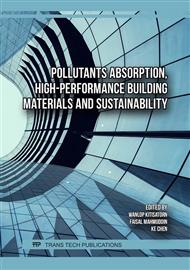[1]
ICOLD, E. D. (2020). Database Presentation. https://www.icoldcigb.org/GB/world_register/ database_presentation.asp
Google Scholar
[2]
Foster, M., Fell, R., & Spannagle, M. (2000). A method for assessing the relative likelihood of failure of embankment dams by piping. Canadian geotechnical journal, 37(5), 1025-1061.
DOI: 10.1139/t00-029
Google Scholar
[3]
USSD. (2021). Introduction to Internal Erosion in Dams and Their FoundationsDecember 2021 Prepared by the USSD Embankment Dams Committee
Google Scholar
[4]
Thay,S., Likitlersuang, S. & Pipatpongsa, T. (2013). Monotonic and Cyclic Behavior of Chiang Mai Sand under Simple Shear Mode. Geotechnical and Geological Engineering 31(1), 67 – 82.
DOI: 10.1007/s10706-012-9563-9
Google Scholar
[5]
Ngo, T.P., Likitlersuang, S. & Takahashi, A. (2019). Performance of a geosynthetic cementitious composite mat for stabilising sandy slopes. Geosynthetic International 26(3), 309-319.
DOI: 10.1680/jgein.19.00020
Google Scholar
[6]
Mase L.Z., Likitlersuang, S. & Tobita, T. (2019). Cyclic Behaviour and Liquefaction Resistance of Izumio Sands in Osaka, Japan. Marine Georesources and Geotechnology 37(7), 765 – 774.
DOI: 10.1080/1064119x.2018.1485793
Google Scholar
[7]
Mase, L.Z., Tanapalungkorn, W., Likitlersuang, S., Ueda, K. & Tobita, T. (2022). Liquefaction analysis of Izumio sands under variation of ground motions during strong earthquake in Osaka, Japan. Soils and Foundations 62(5), 101218.
DOI: 10.1016/j.sandf.2022.101218
Google Scholar
[8]
Sukkarak, R., Tanapalungkorn, W., Likitlersuang, S. & Ueda, K. (2021). Liquefaction analysis of sandy soil during strong earthquake in Northern Thailand. Soils and Foundations 61(5), 1302-1318.
DOI: 10.1016/j.sandf.2021.07.003
Google Scholar
[9]
Kézdi, Á. (1979). Soil physics: selected topics. Elsevier.
Google Scholar
[10]
Ladd, R. (1978). Preparing test specimens using undercompaction. Geotechnical testing journal, 1(1), 16-23.
DOI: 10.1520/gtj10364j
Google Scholar
[11]
Jiang, M., Konrad, J., & Leroueil, S. (2003). An efficient technique for generating homogeneous specimens for DEM studies. Computers and geotechnics, 30(7), 579-597.
DOI: 10.1016/s0266-352x(03)00064-8
Google Scholar
[12]
Lade, P. V., Liggio, C. D., & Yamamuro, J. A. (1998). Effects of non-plastic fines on minimum and maximum void ratios of sand. Geotechnical testing journal, 21, 336-347.
DOI: 10.1520/gtj11373j
Google Scholar
[13]
Yang, S., Lacasse, S., & Sandven, R. (2006). Determination of the transitional fines content of mixtures of sand and non-plastic fines. Geotechnical testing journal, 29(2), 102-107.
DOI: 10.1520/gtj14010
Google Scholar
[14]
Skempton, A., & Brogan, J. (1994). Experiments on piping in sandy gravels. Geotechnique, 44(3), 449-460.
DOI: 10.1680/geot.1994.44.3.449
Google Scholar
[15]
Shire, T., O'Sullivan, C., Hanley, K., & Fannin, R. (2014). Fabric and effective stress distribution in internally unstable soils. Journal of geotechnical and geoenvironmental engineering, 140(12), 04014072.
DOI: 10.1061/(asce)gt.1943-5606.0001184
Google Scholar
[16]
Shire, T., O'Sullivan, C., & Hanley, K. (2016). The influence of fines content and size-ratio on the micro-scale properties of dense bimodal materials. Granular Matter, 18(3), 52.
DOI: 10.1007/s10035-016-0654-9
Google Scholar
[17]
Rochim, A., Marot, D., Sibille, L., & Thao Le, V. (2017). Effects of hydraulic loading history on suffusion susceptibility of cohesionless soils. Journal of geotechnical and geoenvironmental engineering, 143(7), 04017025.
DOI: 10.1061/(asce)gt.1943-5606.0001673
Google Scholar
[18]
Zhong, C., Le, V. T., Bendahmane, F., Marot, D., & Yin, Z.-Y. (2018). Investigation of spatial scale effects on suffusion susceptibility. Journal of geotechnical and geoenvironmental engineering, 144(9), 04018067.
DOI: 10.1061/(asce)gt.1943-5606.0001935
Google Scholar
[19]
Sail, Y., Marot, D., Sibille, L., & Alexis, A. (2011). Suffusion tests on cohesionless granular matter: experimental study. European Journal of Environmental and Civil Engineering, 15(5), 799-
DOI: 10.3166/ejece.15.799-817
Google Scholar



